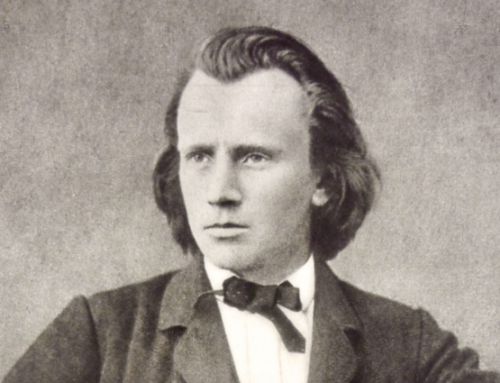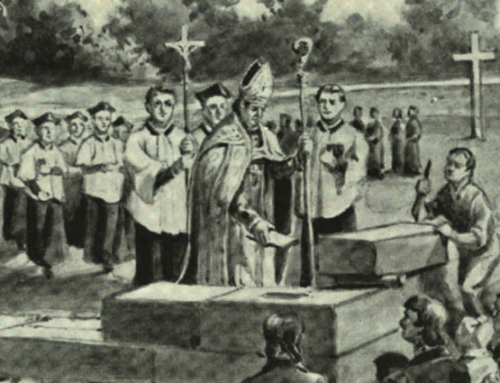“I consider this to be one of my best works,” Hector Berlioz wrote of “The Damnation of Faust.” Though the piece’s spirit is one of unrelenting melancholy, it features much musical diversity and is kaleidoscopic, even cinematic, in its vision. The listener here again recognizes the stunning modernism of Berlioz and finds himself immersed in the unique sound-world of the composer’s imagination.
 “You see,” Hector Berlioz said to a friend after enumerating his torments. “It’s diabolical isn’t it? I mean, it’s once tragic and grotesque. I said I deserved to go to hell… but I’m there!”
“You see,” Hector Berlioz said to a friend after enumerating his torments. “It’s diabolical isn’t it? I mean, it’s once tragic and grotesque. I said I deserved to go to hell… but I’m there!”
Indeed, Hector Berlioz was the archetype of the tortured Romantic soul: a professed atheist who yet felt the pull of his boyhood Catholic faith; a musical composer of great genius whose works often went unappreciated by the public; a worshipper of romantic love who was left disappointed by the realities of married life. To Berlioz, musical expression brought a measure of relief from the demons who tormented him from within and the enemies who attacked him from without. An artist’s work naturally reflects, to some extent, the artist himself; how much of a particular artist’s particular work is autobiographical is a question that is often open to debate. In the case of Hector Berlioz, it is clear that several of his major compositions enshrine his own personal concerns and struggles. The opium-taking, obsessed lover of the famous Symphonie Fantastique (1830) clearly mirrors Berlioz’s own mania about the Irish actress Harriet Smithson; the eponymous hero-artist of his opera Benvenuto Cellini (1838), who defies his enemies to produce the great statue of Perseus cutting off the head of Medusa, is clearly a personification of the composer; and Berlioz’s “sacred oratorio,” L’Enfance du Christ, begun in 1852, likely reflects the suppressed desire of the composer to return to the simplicity of his childhood faith. “O my soul,” the narrator sings at the conclusion of the oratorio, “what remains for thee But to bow thy pride before this mystery? O my heart, be filled with that pure and noble love which alone can open for us the gates of Heaven!”
In the decade prior to his composition of L’Enfance du Christ, Berlioz turned to Johann Wolfgang von Goethe’s play Faust as the basis of a piece that reflected his own disquietude and ongoing search for serenity. Berlioz had been fascinated by Goethe’s take on the Faust legend when he read the German’s work in 1828: “This marvellous book fascinated me from the first,” Berlioz wrote in his Memoirs. “I could not put it down. I read it incessantly, at meals, in the theatre, in the street.” So fired was the twenty-five-year-old Berlioz that he set about composing Eight Scenes from Faust, for voices and orchestra, which he published as his opus 1 in 1829. Fifteen years later, he used this early work as the basis for a more elaborate work; where the Eight Scenes lasts just more than a half-hour, the new composition, which Berlioz called La Damnation de Faust, takes more than two hours.
Like many of Berlioz’s major works, The Damnation of Faust‘s structure defies routine categorization. Featuring only three main characters, and being too episodic in its storyline and too spectacular in its visual conception to be easily staged, it does not meet the typical requirements of opera. Yet Berlioz did not call the piece a symphony, as he had with his similarly large-scale “symphonie dramatique,” Roméo et Juliette (1839), which too featured a chorus and solo voices representing characters in the story. He first deemed Faust a “concert opera” and finally a “légende dramatique.” Years later, Berlioz considered expanding the work into a full-fledged opera, but that project never came to fruition. Since Berlioz’s death, Faust has been given both as a concert performance and as a staged dramatic work. A suite of three orchestral excerpts from the work—”The Hungarian March,” the “Ballet des sylphes,” and the “Menuet des follets”—used to be popular in concert halls.
Berlioz, typically, wrote most of the libretto of Faust himself, “without attempting to translate or even imitate Goethe’s masterpiece, but only to draw inspiration from it and to extract the musical substance that it contained. I composed the score with an ease that I have rarely experienced with my other works.” Faust opens with music of pure melancholy, as we see the protagonist, an aging scholar, alone in the fields on the plains of Hungary. He hears first a joyous chorus of peasants singing, and then the thrilling marching tune of a group of soldiers (the famed Hungarian March), but both sounds leave him cold:
Oh! I suffer! And the starless night
That has just stretched out afar its silence and its veils
Adds still to my dark sorrows.
O earth, for me alone you have no flowers!Where in all the world will I find what my life lacks?
I sought in vain, all fled my bitter desire!
Faust returns to his study and determines to commit suicide, but as he is about take poison he hears people in the streets singing an Easter hymn, which rouses him from his sorrow and stays his hand. Here it is hard to separate the composer/author from the protagonist of the drama:
O memories!
O my trembling soul!
On the wing of these songs will you fly to heaven!
Stumbling faith
Returns, bringing me back the peace of pious days,
My happy childhood,
The sweetness of praying,
The pure joy
Of wandering and dreaming
Through the green fields
At the infinite brightness
Of spring sunshine!
O kiss of celestial love
That filled my heart with sweet presentiments
And chased away every gloomy desire!
Mephistopheles then appears, promising Faust that he “shall enchant your eyes and your ears. Instead of shutting yourself away, sad as the worm That gnaws your books.” Mephistopheles first takes Faust to a tavern, where there is much drunken debauchery… and a little blasphemy. But Faust is disgusted by the scene, so Mephistopheles puts him to sleep and causes him to dream of a beautiful woman, Marguerite. The two meet, and Faust is smitten: “I know at last the prize of life, I have seen happiness, it calls me and I am going to seize it. Love has taken possession of my enraptured soul, It will soon crown my consuming desire.” But when the two are separated for a time, Faust turns away from love, seeking solace in nature, the religion of so many Romantics. Mephistopheles, intent on securing Faust’s soul, tells Faust that Marguerite is in prison, awaiting execution for the accidental murder of her mother, to whom Faust and Marguerite had repeatedly administered a sleeping potion so that they could engage in their amorous trysts undisturbed in the woman’s home.
Frantic as his yearning for Marguerite returns, Faust agrees to sign a pledge agreeing to serve Mephistopheles if he can indeed help Faust rescue Marguerite. Faust’s signature at last secured, Mephistopheles leads the doctor on a harrowing horseback ride to the abyss; they scatter a group of women and children praying before the Cross, and a monster and black birds pursue them. At last Faust plunges into Hell; here Berlioz invents an infernal language for the demons as they celebrate the conquest of Faust’s soul and heap praises upon the victorious Mephistopheles. It is interesting that here Berlioz departs significantly from Goethe’s text; where Goethe finds redemption for the story’s protagonist, Berlioz shows no mercy for his folly of pursuing love at all costs. Is Berlioz here condemning himself for his blind obsession with Harriet Smithson, his first wife, with whom he endured an unhappy marriage? Berlioz does, however, provide some solace at the end of Faust: The work ends with Marguerite’s glorification, as she ascends to Heaven amidst the angels’ comforting song.
“I consider this to be one of my best works,” Berlioz wrote of La Damnation de Faust in his Memoirs. And a century-and-a-half after the composer’s death, we can certainly agree with his assessment. Though the work’s spirit is one of unrelenting melancholy, it features much musical diversity: the jauntiness of soldiers’ marches and students’ choruses, the suave and seductive music of Mephistopheles, two sublime arias sung by Marguerite (“D’amour l’ardente flamme” is often featured in soprano recitals), and the absolutely chilling sounds of the Ride to the Abyss. Indeed, Faust is kaleidoscopic, even cinematic, in its vision. The listener here again recognizes the stunning modernism of Berlioz and finds himself immersed in the unique sound-world of the composer’s imagination.
Despite Berlioz’s satisfaction with Faust, the public was initially much less enthusiastic. Berlioz recalled of the work’s premier: “The concert-going public of Paris, which is supposed to be interested in music, quietly stayed at home, showing as little interest in my new score as if I had been the most obscure student from the Conservatoire.” It would be sad indeed for modern audiences to make the same mistake if The Damnation of Faust happens to be on the concert program of your local opera company or orchestra.
Author’s Note: Below are an excerpt from the Metropolitan Opera’s outstanding, fully-staged 2008 production of La Damnation de Faust, and a concert performance of the complete work.
The Imaginative Conservative applies the principle of appreciation to the discussion of culture and politics—we approach dialogue with magnanimity rather than with mere civility. Will you help us remain a refreshing oasis in the increasingly contentious arena of modern discourse? Please consider donating now.
This is part of a series of essays commemorating the 150th anniversary of the death of Hector Berlioz.
The featured image is “Faust & Méphistophélès” (1930), by Charles S. Ricketts, and is in the public domain, courtesy of Wikimedia Commons.







Leave A Comment